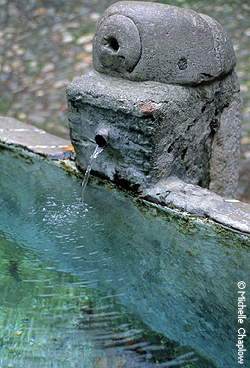Corral del Carbon, Granada

Moorish Fountain inside the Corral de Carbon
The Arabic Word bib means gate and rambla river bank. Until the end of the 19th century, there stood, at the plaza´s east end, a large Moorish gate which gave the place its name - gate of the strand, because it stood on the sandy bank of the river which now flows unseen beneath the Calle de los Reyes Catolicos. A bridge connected it to the the merchants´ inn on the other side, today known as the Corral de Carbon because, after the Moorish period charcoal vendors brought their wares down from the forests to be sold in its patio. This is one of Granada´s oldest and best preserved monuments, with the double-arched gate, inner flag stoned courtyard and central well typical of the Moorish fondaks. I once stayed in a very similar one in Fez, although it didn´t have the magnificent façade.
After the Christian conquest, the patio was used as a theater, and it is easy to imagine it, in the Edad de Oro, all decked out for a comedy for Lope de Vega, with its sunny and shady sections just like today´s bull rings, and subdivided into separate areas for men and women, to prevent licentiousness Later, it became a ramshackle tenement house but is now home to a tourist information office and several crafts and antique shops. An interesting vestige from the time when it was still necessary to cross the river in order to get to the bazaar is the name of the street which leads from it to the Calle Reyes Catolicos: Calle Puente del Carbon, ´´Coal Bridge Street´´.
This excerpt is from Granada, City of My Dreams - an artistic and historical guide for the curious traveler by Lorenzo Bohme
Buy your copy of - Granada, City of My Dreams
 Granada, City of My Dreams: An Historical and Artistic Guide to Granada and its Moorish Palace the Alhambra
Granada, City of My Dreams: An Historical and Artistic Guide to Granada and its Moorish Palace the Alhambra
This itinerary was written for Andaluca.com by Lawrence Boheme author of “Granada, City of My Dreams”. For, what fascinates us about this universal city is not only its monuments but its marvellous story, “the encounter between Moor and Christian, gypsy and Jew, medieval and Renaissance, glistening snow and Mediterranean sun. Lawrence Bohme, poet, illustrator and curious traveller, has filled these pages with luminous descriptions and drawings, the culmination of forty years of wanderings through the palaces and labyrinths. Amazon.co.uk or Amazon.es
Location
C. Mariana Pineda, 21, Centro, 18009 Granada